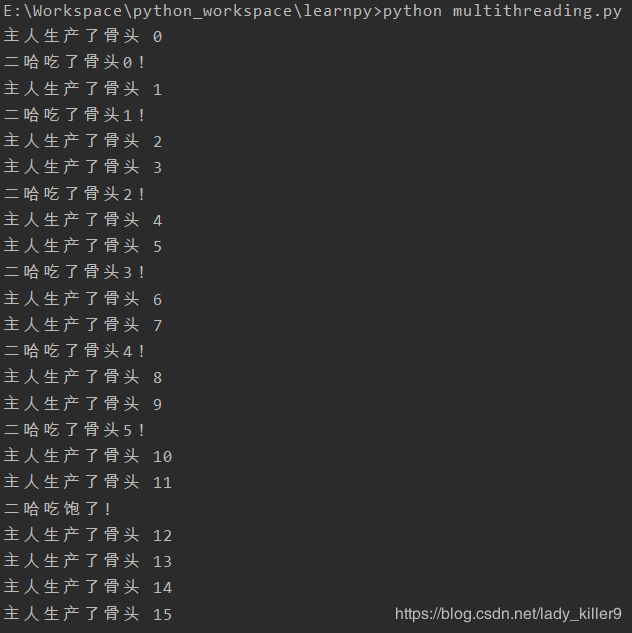python-多线程(池)/多进程(池)及线程同步编程
目录
多线程编程
threading模块
直接调用
派生
多线程池
ThreadPoolExecutor
线程同步
多进程编程
Process类
直接调用
派生
多进程池
multiprocessing.pool
ProcessPoolExecutor
全部代码
参考
多线程编程
Python提供了几个用于多线程编程的模块,包括thread、threading 和Queue等。thread 和threading模块允许程序员创建和管理线程。thread 模块提供了基本的线程和锁的支持,而threading提供了更高级别,功能更强的线程管理的功能。Queue模块允许用户创建-一个可以用于多个线程之间共享数据的队列数据结构。
不建议使用thread模块,threading模块更高级,既然选择python语言,自然是不想像c语言,汇编语言去考虑内存管理,寄存器等底层的东西,而是希望调用各种模块快速开发(虽然运行效率不高)。
threading模块
threading 模块除了包含 _thread 模块中的所有方法外,还提供其他方法:
- threading.currentThread(): 返回当前的线程变量。
- threading.enumerate(): 返回一个包含正在运行的线程的list。正在运行指线程启动后、结束前,不包括启动前和终止后的线程。
- threading.activeCount(): 返回正在运行的线程数量,与len(threading.enumerate())有相同的结果。
除了使用方法外,线程模块同样提供了Thread类来处理线程,Thread类提供了以下方法:
- run(): 用以表示线程活动的方法。
- start():启动线程活动。
- join(timeout=None): 等待至线程中止。这阻塞调用线程直至线程的join() 方法被调用中止-正常退出或者抛出未处理的异常-或者是可选的超时发生。
- isAlive(): 返回线程是否活动的。
- getName(): 返回线程名。
- setName(name): 设置线程名。
直接调用
实例化thread类,调用start()、join()函数。
# 直接实例化Thread
def thread_use():
nloop = 10
threads = []
for i in range(0, nloop):
t = Thread(target=hello, args=('thread' + str(i),))
threads.append(t)
for t in threads:
t.start()
for t in threads:
t.join()直接使用Thread类,不做参数的变化。
派生
# 派生Thread
class myThread(Thread):
def __init__(self, threadID, name, func, args):
Thread.__init__(self)
self.threadID = threadID
self.name = name
self.func = func
self.args = args
def run(self):
print("开始线程:" + self.name)
try:
if self.func:
self.func(*self.args)
finally:
del self.func, self.args
print("退出线程:" + self.name)
# 使用派生线程类
def mythread_use():
nloop = 10
threads = []
for i in range(0, nloop):
t = myThread(i, 'thread' + str(i), hello, args=('thread' + str(i),))
threads.append(t)
for t in threads:
t.start()
for t in threads:
t.join()
主要是修改__init__函数和run函数,对参数和运行方式进行修改。调用方式差不多。
多线程池
ThreadPoolExecutor
# 使用ThreadPoolExecutor
def thread_pool_executor_use():
nloop = 10
executor = ThreadPoolExecutor(4)
for i in range(nloop):
executor.submit(hello, 'thread executor' + str(i))线程同步
使用队列进行同步,先进先出。
# 线程同步-生产者,消费者
q = queue.Queue(maxsize=10)
# 生产者
def Producer(name):
count = 0
while True:
q.put('骨头%s' % count)
print('%s生产了骨头' % name, count)
count += 1
time.sleep(0.5)
if q.qsize() == q.maxsize:
exit(0)
# 消费者
def Consumer(name):
count = 6
while count:
count -= 1
print('%s吃了%s!' % (name, q.get()))
time.sleep(1)
print('%s吃饱了!' % name)
exit(0)
# 线程同步
def thread_synch():
p = Thread(target=Producer, args=('主人',))
p.start()
c = Thread(target=Consumer, args=('二哈',))
c.start()
多进程编程
Process类
和Thread类差不多,3.7有些优化,kill,close函数等。
直接调用
# 直接实例化Process
def process_use():
nloop = 10
processes = []
for i in range(0, nloop):
p = Process(target=hello, args=('process' + str(i),))
processes.append(p)
for p in processes:
p.start()
for p in processes:
p.join()派生
同样是修改__init__函数和run函数,不做赘述。
多进程池
multiprocessing.pool
常用apply_async和map函数
# 进程池
def process_pool_use():
nloop = 10
arg_list = []
with Pool(processes=4) as pool: # start 4 worker processes
for i in range(nloop):
pool.apply_async(hello, ('process'+str(i),)) # evaluate "f(10)" asynchronously in a single process
arg_list.append('process'+str(i))
pool.map(hello, arg_list)
pool.close()
pool.join()
ProcessPoolExecutor
# 使用ProcessPoolExecutor
def process_pool_executor_use():
nloop = 10
executor = ProcessPoolExecutor(4)
for i in range(nloop):
executor.submit(hello, 'process executor' + str(i))全部代码
"""
--coding:utf-8--
@File: multithreading.py
@Author:frank yu
@DateTime: 2020.07.21 18:32
@Contact: [email protected]
"""
from threading import Thread
from concurrent.futures import ThreadPoolExecutor, ProcessPoolExecutor
from multiprocessing import Process, Pool
import queue
import time
# 简单的输出函数
def hello(con):
print('hello,' + con)
# 派生Thread
class myThread(Thread):
def __init__(self, threadID, name, func, args):
Thread.__init__(self)
self.threadID = threadID
self.name = name
self.func = func
self.args = args
def run(self):
print("开始线程:" + self.name)
try:
if self.func:
self.func(*self.args)
finally:
del self.func, self.args
print("退出线程:" + self.name)
# 直接实例化Thread
def thread_use():
nloop = 10
threads = []
for i in range(0, nloop):
t = Thread(target=hello, args=('thread' + str(i),))
threads.append(t)
for t in threads:
t.start()
for t in threads:
t.join()
# 使用派生线程类
def mythread_use():
nloop = 10
threads = []
for i in range(0, nloop):
t = myThread(i, 'thread' + str(i), hello, args=('thread' + str(i),))
threads.append(t)
for t in threads:
t.start()
for t in threads:
t.join()
# 使用ThreadPoolExecutor
def thread_pool_executor_use():
nloop = 10
executor = ThreadPoolExecutor(4)
for i in range(nloop):
executor.submit(hello, 'thread executor' + str(i))
# 线程同步-生产者,消费者
q = queue.Queue(maxsize=10)
# 生产者
def Producer(name):
count = 0
while True:
q.put('骨头%s' % count)
print('%s生产了骨头' % name, count)
count += 1
time.sleep(0.5)
if q.qsize() == q.maxsize:
exit(0)
# 消费者
def Consumer(name):
count = 6
while count:
count -= 1
print('%s吃了%s!' % (name, q.get()))
time.sleep(1)
print('%s吃饱了!' % name)
exit(0)
# 线程同步
def thread_synch():
p = Thread(target=Producer, args=('主人',))
p.start()
c = Thread(target=Consumer, args=('二哈',))
c.start()
# 直接实例化Process
def process_use():
nloop = 10
processes = []
for i in range(0, nloop):
p = Process(target=hello, args=('process' + str(i),))
processes.append(p)
for p in processes:
p.start()
for p in processes:
p.join()
# 进程池
def process_pool_use():
nloop = 10
arg_list = []
with Pool(processes=4) as pool: # start 4 worker processes
for i in range(nloop):
pool.apply_async(hello, ('process' + str(i),)) # evaluate "f(10)" asynchronously in a single process
arg_list.append('process' + str(i))
pool.map(hello, arg_list)
pool.close()
pool.join()
# 使用ProcessPoolExecutor
def process_pool_executor_use():
nloop = 10
executor = ProcessPoolExecutor(4)
for i in range(nloop):
executor.submit(hello, 'process executor' + str(i))
if __name__ == "__main__":
# thread_use()
# mythread_use()
# thread_pool_executor_use()
thread_synch()
# process_use()
# process_pool_use()
# process_pool_executor_use()
参考
python 3.7官方文档:threading-基于线程的并行
python 3.7官方文档:processing-基于进程的并行
python 3.7官方文档:concurrent.futures--- 启动并行任务






